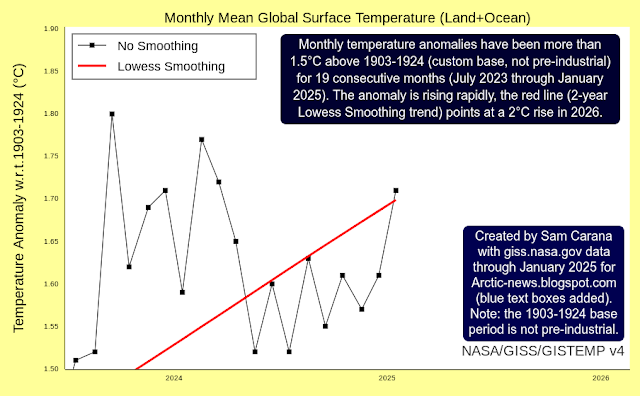The image below, made with a screenshot from Berkeley Earth, shows an annual average temperature rise of 3°C or more in 2050 in China for each of the three scenarios looked at.
China is important, it has a large well-educated population and a large part of global emissions is released in China. Some countries face even more dire prospects. Have people been told how dire the situation is? The general lack of climate action around the world suggests that people have not been sufficiently informed. Moreover, many scientists, journalists, judges, politicians and civil servants bluntly refuse to inform people.
 |
| [ from earlier post ] |
 |
| [ Top: Extreme risk impact, adapted from Planetary Solvency actuaries.org.uk (2025). Bottom: 5.163°C rise, climatereanalyzer.org image, from earlier post ] |
The image below shows the January 2025 temperature anomaly, compared to NASA's default 1951-1980 base.
The image below shows that monthly temperature anomalies have been more than 1.5°C above 1903-1924 (custom base, not pre-industrial) for 19 consecutive months (July 2023 through January 2025). The anomaly is rising rapidly, the red line (2-year Lowess Smoothing trend) points at a 2°C rise in 2026 (compared to 1903-1924, which - as said - is not pre-industrial).
Will a new El Niño emerge in the course of 2025?
La Niña conditions are currently present. The probabilities of El Niño conditions are expected to rise in the course of 2025. Moving from the bottom of a La Niña to the peak of a strong El Niño could make a difference of more than 0.5°C, as illustrated by the image below. |
| [ Temperature rise due to El Niño from earlier post ] |
 |
| [ temperature anomaly through January 2025 colored by ENSO values, click to enlarge ] |
Earth's temperature imbalance is growing, as emissions and temperatures keep rising. In a cataclysmic alignment, the upcoming El Niño threatens to develop while sunspots are higher than expected. Sunspots are predicted to peak in July 2025. The temperature difference between maximum versus minimum sunspots could be as much as 0.25°C.
There are further mechanisms that could accelerate the temperature rise, such as reductions in aerosols that are currently masking global warming. Furthermore, the temperature rise comes with numerous feedbacks such as loss of sea ice, loss of lower clouds, more water vapor in the atmosphere and changes in wind patterns and ocean currents that could cause extreme weather events such as forest fires and flooding to increase in frequency, intensity, duration and area covered, and oceans to take up less heat, with more heat instead remaining in the atmosphere. The self-reinforcing nature of many of these feedbacks could cause the temperature rise to accelerate strongly and rapidly within a few months time.
According to an earlier analysis, the 2°C above pre-industrial threshold may already have been crossed and we're moving toward 3°C at a pace that is accelerating, rather than slowing down. Once more, isn't it high time for people to be told how dire the situation is?
Double Blue Ocean Event 2025?
 |
| [ from earlier post ] |
Antarctic sea ice is moving toward 1 million km² in area, a threshold when a Blue Ocean Event could be declared in the Southern Hemisphere, as illustrated by the image below.
 |
| [ Arctic sea ice volume, click to enlarge ] |
Ominously, Arctic sea ice volume is at a record low for the time of year, as illustrated by the image on the right, showing Arctic sea ice volume on February 15, 2025.
An Arctic Blue Ocean Event threatens to destabilize hydrates contained in sediments at the seafloor of the Arctic Ocean, causing eruptions of huge amounts of methane, with the resulting temperature rise in the Arctic causing permafrost on land to thaw strongly and abruptly, in turn causing additional greenhouse gas releases.
The above image shows methane as high as 2561 ppb at 399.1 mb recorded by the N21 satellite on February 5, 2025 am.
 |
| [ for more background, also view the Extinction page ] |
The temperature rise itself triggers further feedbacks such as an increase of water vapor in the atmosphere (2.1°C) and loss of lower clouds (8°C). Altogether, the rise could reach 18.44°C by the end of 2026. Warnings about the potential for such a rise have been sounded before, e.g. at the extinction page. Note the above-mentioned warning that humans will likely go extinct with a 3°C rise.
The situation is dire and the precautionary principle calls for rapid, comprehensive and effective action to reduce the damage and to improve the situation, as described in this 2022 post, where needed in combination with a Climate Emergency Declaration, as discussed at this group.
Links
• Berkeley Earth - policy insights
https://berkeleyearth.org/policy-insights
• Climate Reanalyzer
https://climatereanalyzer.org
• Did a Terminal Temperature Acceleration Event start in December 2024?
https://arctic-news.blogspot.com/2024/12/did-a-terminal-temperature-acceleration-event-start-in-december-2024.html
• Danish Meteorological Institute - Arctic sea ice volume and thickness
https://ocean.dmi.dk/arctic/icethickness/thk.uk.php
• Why downplay the need for action?
https://arctic-news.blogspot.com/2025/01/why-downplay-the-need-for-action.html
• Paris Agreement
https://unfccc.int/process-and-meetings/the-paris-agreement
• pre-industrial
https://arctic-news.blogspot.com/p/pre-industrial.html
• Extinction
https://arctic-news.blogspot.com/p/extinction.html
• When will we die?
https://arctic-news.blogspot.com/2019/06/when-will-we-die.html
• Institute and Faculty of Actuaries - Finding our balance with nature: introducing Planetary Solvency
https://blog.actuaries.org.uk/finding-our-balance-with-nature-introducing-planetary-solvency
discussed on facebook at:
https://www.facebook.com/groups/arcticnews/posts/10162300677224679
• Copernicus - Global surface air temperature
https://pulse.climate.copernicus.eu
• Sunspots
https://arctic-news.blogspot.com/p/sunspots.html
• NOAA - Monthly Temperature Anomalies Versus El Niño/La Niña through January 2025
• NOAA - EL NIÑO/SOUTHERN OSCILLATION (ENSO) - 13 February 2025
https://www.cpc.ncep.noaa.gov/products/analysis_monitoring/enso_advisory/ensodisc.shtml
• IRI - CPC Official Probabilistic ENSO Forecast
• seaice.visuals.earth
https://seaice.visuals.earth
https://english.elpais.com/climate/2025-02-12/massive-methane-leaks-detected-in-antarctica-posing-potential-risks-for-global-warming.html
https://ocean.dmi.dk/arctic/icethickness/thk.uk.php
• Transforming Society
https://arctic-news.blogspot.com/2022/10/transforming-society.html
• Climate Plan
https://arctic-news.blogspot.com/p/climateplan.html
• Climate Emergency Declaration
https://arctic-news.blogspot.com/p/climate-emergency-declaration.html














































